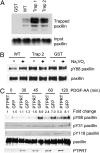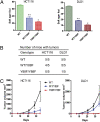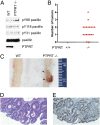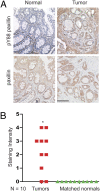Identification and functional characterization of paxillin as a target of protein tyrosine phosphatase receptor T
- PMID: 20133777
- PMCID: PMC2823898
- DOI: 10.1073/pnas.0914884107
Identification and functional characterization of paxillin as a target of protein tyrosine phosphatase receptor T
Abstract
Protein tyrosine phosphatase receptor-type T (PTPRT) is the most frequently mutated tyrosine phosphatase in human cancers. However, the cell signaling pathways regulated by PTPRT largely remain to be elucidated. Here, we show that paxillin is a direct substrate of PTPRT and that PTPRT specifically regulates paxillin phosphorylation at tyrosine residue 88 (Y88) in colorectal cancer (CRC) cells. We engineered CRC cells homozygous for a paxillin Y88F knock-in mutant and found that these cells exhibit significantly reduced cell migration and impaired anchorage-independent growth, fail to form xenograft tumors in nude mice, and have decreased phosphorylation of p130CAS, SHP2, and AKT. PTPRT knockout mice that we generated exhibit increased levels of colonic paxillin phosphorylation at residue Y88 and are highly susceptible to carcinogen azoxymethane-induced colon tumor, providing critical in vivo evidence that PTPRT normally functions as a tumor suppressor. Moreover, similarly increased paxillin pY88 is also found as a common feature of human colon cancers. These studies reveal an important signaling pathway that plays a critical role in colorectal tumorigenesis.
Conflict of interest statement
The authors declare no conflict of interest.
Figures





Similar articles
-
Regulation of paxillin-p130-PI3K-AKT signaling axis by Src and PTPRT impacts colon tumorigenesis.Oncotarget. 2017 Jul 25;8(30):48782-48793. doi: 10.18632/oncotarget.10654. Oncotarget. 2017. PMID: 27447856 Free PMC article.
-
Identification and functional characterization of p130Cas as a substrate of protein tyrosine phosphatase nonreceptor 14.Oncogene. 2013 Apr 18;32(16):2087-95. doi: 10.1038/onc.2012.220. Epub 2012 Jun 18. Oncogene. 2013. PMID: 22710723 Free PMC article.
-
Identification of STAT3 as a substrate of receptor protein tyrosine phosphatase T.Proc Natl Acad Sci U S A. 2007 Mar 6;104(10):4060-4. doi: 10.1073/pnas.0611665104. Epub 2007 Feb 21. Proc Natl Acad Sci U S A. 2007. PMID: 17360477 Free PMC article.
-
Tumour suppressor function of protein tyrosine phosphatase receptor-T.Biosci Rep. 2011 Oct;31(5):303-7. doi: 10.1042/BSR20100134. Biosci Rep. 2011. PMID: 21517784 Free PMC article. Review.
-
Protein tyrosine phosphatase PTPRT as a regulator of synaptic formation and neuronal development.BMB Rep. 2015 May;48(5):249-55. doi: 10.5483/bmbrep.2015.48.5.037. BMB Rep. 2015. PMID: 25748173 Free PMC article. Review.
Cited by
-
Colorectal cancers utilize glutamine as an anaplerotic substrate of the TCA cycle in vivo.Sci Rep. 2019 Dec 16;9(1):19180. doi: 10.1038/s41598-019-55718-2. Sci Rep. 2019. PMID: 31844152 Free PMC article.
-
PD-L1 expression is regulated by ATP-binding of the ERBB3 pseudokinase domain.Genes Dis. 2022 Dec 8;10(4):1702-1713. doi: 10.1016/j.gendis.2022.11.003. eCollection 2023 Jul. Genes Dis. 2022. PMID: 37397533 Free PMC article.
-
Identification of unbalanced genome copy number abnormalities in patients with multiple myeloma by single-nucleotide polymorphism genotyping microarray analysis.Int J Hematol. 2012 Oct;96(4):492-500. doi: 10.1007/s12185-012-1171-1. Epub 2012 Sep 13. Int J Hematol. 2012. PMID: 22972171
-
PTPRT and PTPRD Deleterious Mutations and Deletion Predict Bevacizumab Resistance in Metastatic Colorectal Cancer Patients.Cancers (Basel). 2018 Sep 6;10(9):314. doi: 10.3390/cancers10090314. Cancers (Basel). 2018. PMID: 30200630 Free PMC article.
-
Astrocyte Structural and Molecular Response to Elevated Intraocular Pressure Occurs Rapidly and Precedes Axonal Tubulin Rearrangement within the Optic Nerve Head in a Rat Model.PLoS One. 2016 Nov 28;11(11):e0167364. doi: 10.1371/journal.pone.0167364. eCollection 2016. PLoS One. 2016. PMID: 27893827 Free PMC article.
References
-
- Blume-Jensen P, Hunter T. Oncogenic kinase signalling. Nature. 2001;411:355–365. - PubMed
-
- Wang Z, et al. Mutational analysis of the tyrosine phosphatome in colorectal cancers. Science. 2004;304:1164–1166. - PubMed
-
- Schaller MD, Parsons JT. Focal adhesion kinase and associated proteins. Curr Opin Cell Biol. 1994;6:705–710. - PubMed
Publication types
MeSH terms
Substances
Grants and funding
LinkOut - more resources
Full Text Sources
Other Literature Sources
Molecular Biology Databases

